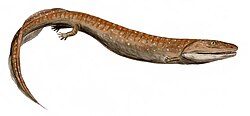| Megistolepis Temporal range: Carboniferous | |
|---|---|
| Scientific classification | |
| Domain: | Eukaryota |
| Kingdom: | Animalia |
| Phylum: | Chordata |
| Clade: | Sarcopterygii |
| Clade: | Tetrapodomorpha |
| Family: | † Megalichthyidae |
| Genus: | † Megistolepis Obruchev, 1955 |
Megistolepis is a genus of prehistoric lobe-finned fish which lived during the Carboniferous period. [1]





